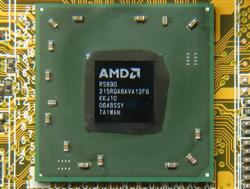 18
18
AMD 690 Chipset Series Preview Review
HDMI 1.3 & Gaming Performance »Introduction

With the AMD and ATI merger on October 25th 2006, two giant companies of very different areas came together and many were worried about the future of the ATI brand. Over the last few months it has become more than apparent that the brand will live on, but some were concerned about the future mainboard chipsets. While NVIDIA has had a firm grip on the chipset market for some time, offering both AMD and Intel based solutions, there is a new guy in town. AMD is launching the first chipset that was created under the AMD/ATI brand, called the 690 chipset. The chipset is fully featured and there two variants. Both use the same silicon, but certain features are simply disabled, the Southbridge can be chosen by the motherboard manufacturer, with the AMD SB600 the best choice. The two variants are AMD 690G and 690V.
As you can see, the Northbridge chip itself is quite small and can easily be passively cooled. It has a heat output of approximately 7 Watts, which makes it a good choice for notebook platforms as well. The chipset includes a lot of features on-die, without the use of any external chips or controllers. This reduces the overall price of a mainboard, as there is no need to buy separate chips for HDMI, for example. The AMD 690 costs a mere $15 USD for motherboard makers, which helps keep the board price down. The integrated ATI Radeon X1250 GPU can handle games much better than any previous on-board graphics card, it is comparable to a Radeon 9700 in performance. Using FSAA and AA with the X1250 is certainly a possibility. AMD has also focused on avoiding a driver mess and delivers support for the X1250 with the proven Catalyst Driver Suite. A unified driver is used for all integrated, mobile and discrete graphics which makes it much easier for users to find the right driver - there is only one.
The chipset is not only the first joint AMD and ATI product, but there are a few new mainboard manufacturers producing boards using an AMD based chips for the first time. Biostar, Foxconn and Gigabyte will be joining the long list of manufacturers to produce boards on AMD chipsets.
AMD 690 Variants
As mentioned before, there are two variants of the AMD 690 - the 690G and 690V. The difference between them is twofold. The 690G is fully featured, with HDMI & DVI output named Radeon XPress 1250, while the 690V lacks HDMI or DVI by using a D-Sub VGA output with simple TV-Out and therefore features a Radeon XPress 1200 GPU. The ATI Radeon X1200-family IGP has two pixel-pipelines and two vertex-shaders. AMD specifies the GPU to run at 400 MHz. While this may not sound like much, it is faster than any integrated solution that NVIDIA or Intel have to offer. The video memory is shared with the motherboard's main memory, which means that a portion (32 MB to 256 MB) can be allocated by the BIOS for video use only.While the focus is on highly integrated desktop parts, the AMD 690G will also be available in Notebooks and will be called the M690G. There is no physical difference between the 690G and the M690G. The M690G can be paired with a small DRAM chip on-board, which stores the VGA frame buffer. This lets the IGP go into a deeper sleep state because video memory does not need to be refreshed. Such a small features can add up to 20 minutes of battery life. This power saving feature can only be activated while 2D Windows is active, because it saves only what is displayed on your screen, not textures or geometry.
Let's take a look at the overall features.
Apr 18th, 2024 05:34 EDT
change timezone
Latest GPU Drivers
New Forum Posts
- Which air cooler for a ryzen 9 5900x (154)
- Unlocked Realtek HD Audio Drivers for Windows 11 (Dolby Digital Live/DTS Interactive) (151)
- Will a RTX 4070 TI super bottleneck a Ryzen 9 7950X3D? (31)
- Issue of the RTX 4050's L2 Cache in the Techpowerup GPU Database (0)
- Realtek Modded Audio Driver for Windows 10/11 - Only for HDAUDIO (5676)
- Post your JetStream 2 speeds! (140)
- The TPU UK Clubhouse (24725)
- Sold my a working PSU that I have been using, but buyer says it sparked at the outlet when he plugged it in and asking for a possible refund (9)
- Gigabyte gpu model differences? (30)
- Identify my GPU - RX 570 8GB (or what?) (1)
Popular Reviews
- Horizon Forbidden West Performance Benchmark Review - 30 GPUs Tested
- PowerColor Radeon RX 7900 GRE Hellhound Review
- ASUS GeForce RTX 4090 Matrix Platinum Review - The RTX 4090 Ti
- Fractal Design Terra Review
- Corsair 2000D Airflow Review
- Minisforum EliteMini UM780 XTX (AMD Ryzen 7 7840HS) Review
- Creative Pebble X Plus Review
- FiiO KB3 HiFi Mechanical Keyboard Review - Integrated DAC/Amp!
- ASUS GeForce RTX 4090 STRIX OC Review
- NVIDIA GeForce RTX 4090 Founders Edition Review - Impressive Performance
Controversial News Posts
- Sony PlayStation 5 Pro Specifications Confirmed, Console Arrives Before Holidays (106)
- NVIDIA Points Intel Raptor Lake CPU Users to Get Help from Intel Amid System Instability Issues (102)
- US Government Wants Nuclear Plants to Offload AI Data Center Expansion (98)
- Windows 10 Security Updates to Cost $61 After 2025, $427 by 2028 (82)
- Developers of Outpost Infinity Siege Recommend Underclocking i9-13900K and i9-14900K for Stability on Machines with RTX 4090 (82)
- TechPowerUp Hiring: Reviewers Wanted for Motherboards, Laptops, Gaming Handhelds and Prebuilt Desktops (71)
- Intel Realizes the Only Way to Save x86 is to Democratize it, Reopens x86 IP Licensing (70)
- AMD Zen 5 Execution Engine Leaked, Features True 512-bit FPU (63)

